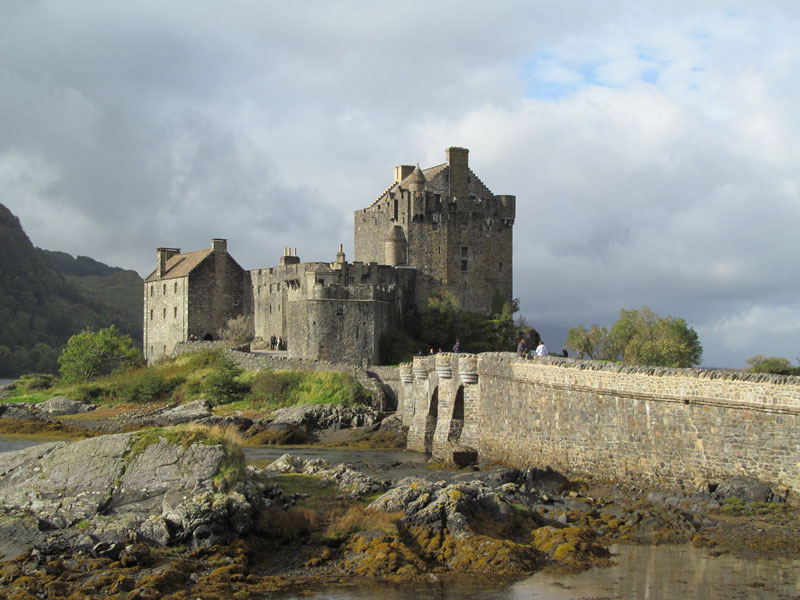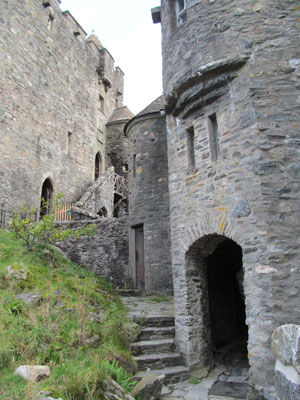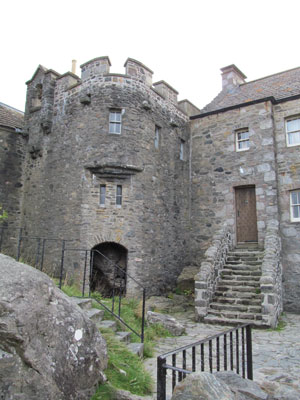The Highland castle of Eilean Donan
A quick Internet check told me that there were once two to three thousand castles in Scotland. Many still exist as family homes, castle hotels or tourist attractions. Some remain picturesque ruins. Others have simply vanished with hardly a trace, their stones incorporated long ago into other buildings.
Of all these castles, there is one that is the iconic Scottish castle. It appears in countless travel brochures and on posters, calendars and postcards and — as I discovered while shopping in an Edinburgh supermarket — on half of the tin containers of shortbread cookies.
Eilean Donan Castle is located on a small island in the western Highlands of Scotland where three lochs, or lakes, meet. With forested mountains bordering the lochs, it is a place of serene beauty.
The name Eilean Donan means “Island of Donan.” Donan was a Celtic priest who went to Scotland around A.D. 580 and was martyred there in 617. Legend says that he may have lived in a monastic cell on Eilean Donan (unlikely) or that a chapel may have been built on the island after his death to commemorate him (likely), but no trace of either has yet been found.
Early history
Early in the 13th century, during the reign of the Scottish King Alexander II (1214-1249), a castle was built on the island probably as a defense against the Norsemen who controlled much of northern Scotland and the Western Isles at the time.
This earliest castle occupied almost the entire island, an island which was enclosed within massive stone curtain walls studded with towers. Yet by the end of the following century, the size of the castle had been reduced to one-fifth of its original size. A much smaller enclosure centered on a tower house/keep, making it easier to garrison the castle.
Eilean Donan’s history has been turbulent. After the mid-13th century and the disappearance of the Norse threat, this area of Scotland became the “Sea Kingdom,” the realm of the Lord of the Isles, whose strength lay in sea galleys and the men who sailed them. There was almost constant feuding among the clan chiefs of the isles.
Clan castle
The island and its castle belonged to the MacKenzies of Kintail, but it was often garrisoned by the MacRae clan, who resettled there in the 14th century, becoming “bodyguards” for the MacKenzies.
According to clan history, Robert the Bruce, king of the Scots from 1306 to 1329 as well as Scotland’s national hero who led the country during the Wars of Independence against England, is said to have taken refuge from the English in Eilean Donan Castle in 1306-1307.
Feuding continued during the 15th and 16th centuries — the MacKenzies against the Earl of Huntly, against the MacDonalds and against the MacLeods.
In the 17th and 18th centuries, many of the Scottish Highlanders were Jacobites, supporters of the English King James II, the great grandson of Mary Queen of Scots. James II was deposed in 1689 because of his Roman Catholicism and replaced by his daughter, Mary, who ruled jointly with her husband, William of Orange.
Jacobite uprisings occurred regularly for almost 60 years (1688 to 1746), with unsuccessful attempts to restore James II, his son or his grandson to the English throne.
Eilean Donan became part of this long conflict in 1719 when a small band of Spanish soldiers occupied the castle as a prelude to a supposed larger Spanish invasion in support of the Jacobite cause. The Royal Navy sent three ships, which bombarded the castle and completely destroyed what was left by exploding barrels of gunpowder they found stored inside.
The remnants of Eilean Donan lay abandoned for almost 200 years until restored between 1911 and 1932 by one of the MacRae clan, Lt. Col. John MacRae-Gilstrap. The castle has been open to the public since 1955.
Castle tour
Today visitors cross a long, arched, stone bridge to the island castle, entering a gatehouse leading into a small courtyard facing the sheer wall of the castle keep. If all else failed, this keep or tower house was the final line of defense against invaders.
Entering the keep, built upon the craggy bedrock of the island, visitors first come to the barrel-vaulted Billeting Room. This was once the living quarters of the castle soldiers and, after the early-20th-century restoration, part of the summer home of the MacRae-Gilstrap family.
There’s an 18th-century tea set displayed that was once used by Dr. Samuel Johnson and James Boswell when they toured the Hebrides in 1773. There are also dueling pistols and short dirks (daggers) on view.
Above this room is the Banqueting Hall, with a huge fireplace and ceiling beams of Canadian Douglas fir, a gift of the MacRae clan living in Canada.
There are numerous artifacts to see in the hall: an oval table from one of Admiral Nelson’s ships, a lock of Bonnie Prince Charlie’s hair (he was the grandson of the deposed James II) and drinking cups made from cannonballs. One flight up are six cozy bedrooms, and below is a kitchen re-created to look as it did 100 years ago.
Outside, visitors can walk around the island to see the castle reflected in the waters of the lochs. The bridge nearby leads to the Isle of Skye.
Having visited Eilean Donan Castle, I now understand why it has appeared on so many calendars and postcards. I have to admit I couldn’t resist buying a tea towel with the castle’s image imprinted on it.
If you go…
Hours for visiting Eilean Donan Castle are irregular. You should check the website. The admission fee is £6.50 (about $10.50).
My husband, Paul, and I visited Eilean Donan Castle in October 2013 as part of a 2-night, 3-day trip from Edinburgh to the Isle of Skye. We traveled with Rabbie’s, a first-rate company offering small-group tours (maximum of 16 passengers) throughout Scotland and northern England.
In addition to the multiday tours, ranging from two to six days, to places like Inverness, Hadrian’s Wall in northern England and the Isle of Skye, a wide selection of day tours — including trips to Loch Ness, St. Andrews and Rosslyn Chapel — is offered by Rabbie’s (No. One Currency Bureau, 207 High St., Royal Mile, Edinburgh, EH1 1PE, Scotland; phone 44 [0] 131 226 3133, fax 131 225 7028).
Besides our tour to the Isle of Skye, we took Rabbie’s day excursion to Stirling Castle, where Mary Queen of Scots was crowned as a baby.
Our trip to the Isle of Skye cost £119 ($195) each and did not include accommodations, meals or admissions. On the Isle of Skye, we stayed in Portree at the superlative Cuillin Hills Hotel, where our room with canopied four-poster bed overlooked the water and the hills beyond.
Our room cost £190 ($311), including full Scottish breakfast. We sampled single malt whiskey, including the Isle of Skye’s own Talisker brand, in the hotel bar.
In her next column, Julie will describe three medieval abbeys she visited in the Scottish Borders not far from Edinburgh.



